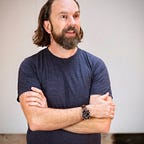Interview with Danny Hearn
In advance of the Leading Design conference in London on the 24th-26th October, I caught up with Danny Hearn to discuss his background, experience and thoughts on the subject of Design Leadership.
Tell us about your first design leadership role?
My first real design leadership role was at John Lewis as UX Manager. I needed to develop the UX practice after we had moved from waterfall to agile delivery. The industry seemed to have no template and or guidance into how UX teams in Enterprises could develop and deliver designs for agile-based delivery.
I started by running a workshop session with my team and asking them “What they understood their job was?” then “What stops you doing it even better?”. This opened up a wide range of topics. The biggest insight that the team felt, was that only UX cared and understood customers needs and that it was leading to conflict in design and prioritisation discussions. This gave me a really clear starting point. How do I make everyone in the streams ‘care’ and understand the customer? This led me and the team to explore different ways to communicate user insights and understanding using wall-sized design canvas’s, co-design collaborative sessions and developing our design critique process. We then developed a research model that integrated lean principles and value proposition design into our delivery model.
Following that I turned my attention to business-wide strategy as well as looking at the format of how business cases were written. This was key to creating real change and influence. I identified processes and techniques to embed customer ‘hooks’ that would trickle through the strategy directly into our design sprints as a KPI and guiding star that would ensure everyone cared about the customer.
Who did you model yourself on?
I feel a bit cliched to admit this, but reading the Steve Jobs biography by Walter Isaacson and how he disrupted his own company from within, was a real inspiration and had a big impact on me. I loved the way he didn’t settle and would challenge the seemingly minute details to accept nothing less than insanely great design.
What does a typical day look like for you? Is it all meetings?
In my role as UX Manager, I would rarely be at my desk, often moving around the department floor, I liked to joke that I was ‘doing the rounds’. In all seriousness if I had an hour free I would just walk around the department, chatting to designers, BAs and devs to help build a broader understanding of what was happening and why. After time people opened up to me more, sharing subtle insights into their frustrations or progress on projects that wouldn’t always be reported at higher levels of management. And yes as it was a large company there were also lots of meetings!
Do you still get to do any “real” design?
Whilst in my role as UX Manager I did jump in on a few occasions to do real design either to support the team or as the sole designer. I’ve recently changed my role to go into freelancing UX, meaning I’m now back on the shop floor doing real design.
What are the qualities of a good design leader?
To listen, talk, challenge people, build rapport. Have an opinion, not just what’s wrong, but also how you think it could be better. Once you start to really understand your challenges, you need to form that into a clear narrative and create a shared understanding — with those around you — of where we’ve been and where we are now. The next steps for the future should then be created bottom up by the team. Guide and nudge, but for a successful leadership to work, the team need to own it, not some boss with a flashy title!
What are you most proud of achieving as a design leader?
Creating a vision with my team, that had a big impact on the culture and practice at such a large organisation like John Lewis. The was achieved by listening, talking and socialising ideas that could impact the way we briefed, measured and delivered projects. I looked at LEAN principles, and value proposition design and developed practical ways to directly apply it within the John Lewis Enterprise delivery model. With a lot of persistence I was able to win hearts and minds of the online team and wider parts of the business, whilst also getting my team to own it and take it on as their own practice.
